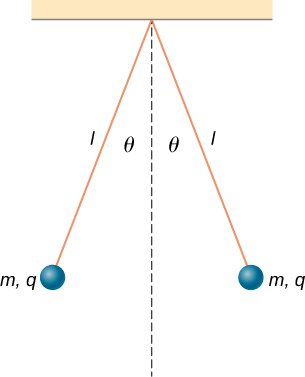| << Chapter < Page | Chapter >> Page > |
During fair weather, the electric field due to the net charge on Earth points downward. Is Earth charged positively or negatively?
If the electric field at a point on the line between two charges is zero, what do you know about the charges?
The charges are of the same sign.
Two charges lie along the x -axis. Is it true that the net electric field always vanishes at some point (other than infinity) along the x -axis?
A particle of charge experiences an upward force of magnitude when it is placed in a particular point in an electric field. (a) What is the electric field at that point? (b) If a charge is placed there, what is the force on it?
a.
;
b.
On a typical clear day, the atmospheric electric field points downward and has a magnitude of approximately 100 N/C. Compare the gravitational and electric forces on a small dust particle of mass that carries a single electron charge. What is the acceleration (both magnitude and direction) of the dust particle?
Consider an electron that is from an alpha particle (a) What is the electric field due to the alpha particle at the location of the electron? (b) What is the electric field due to the electron at the location of the alpha particle? (c) What is the electric force on the alpha particle? On the electron?
a.
;
b.
;
c.
on alpha particle;
on electron
Each the balls shown below carries a charge q and has a mass m . The length of each thread is l , and at equilibrium, the balls are separated by an angle . How does vary with q and l ? Show that satisfies
.

What is the electric field at a point where the force on a charge is
A proton is suspended in the air by an electric field at the surface of Earth. What is the strength of this electric field?
The electric field in a particular thundercloud is What is the acceleration of an electron in this field?
,
A small piece of cork whose mass is 2.0 g is given a charge of What electric field is needed to place the cork in equilibrium under the combined electric and gravitational forces?
If the electric field is at a distance of 50 cm from a point charge q , what is the value of q ?
What is the electric field of a proton at the first Bohr orbit for hydrogen What is the force on the electron in that orbit?
(a) What is the electric field of an oxygen nucleus at a point that is from the nucleus? (b) What is the force this electric field exerts on a second oxygen nucleus placed at that point?
a.
;
b.
Two point charges, and are held 25.0 cm apart. (a) What is the electric field at a point 5.0 cm from the negative charge and along the line between the two charges? (b)What is the force on an electron placed at that point?
Point charges and are placed 1.0 m apart. (a) What is the electric field at a point midway between them? (b) What is the force on a charge situated there?
If the
is to the right of
the electric field vector from both charges point to the right. a.
;
b.
Can you arrange the two point charges and along the x -axis so that at the origin?
Point charges are fixed on the x -axis at and What charge q must be placed at the origin so that the electric field vanishes at
There is
right triangle geometry. The
x -components of the electric field at
cancel. The
y -components give
.
At the origin we have a a negative charge of magnitide
.

Notification Switch
Would you like to follow the 'University physics volume 2' conversation and receive update notifications?